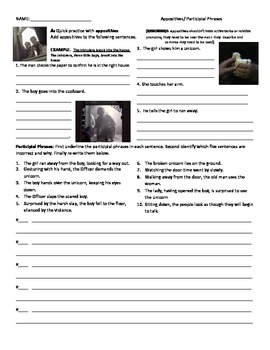 This blog is written for the 36th edition of the ELT Blog Carnival focusing on how to use videos in education!
This blog is written for the 36th edition of the ELT Blog Carnival focusing on how to use videos in education!I've talked about using videos with participle phrases before with music videos. This blog will talk about another way I like to use videos with participial phrases.
Some background. This lesson is designed for high school students whose overall semester has covered multiple themes of tolerance (e.g bullying). They have been introduced to the topic of participial phrases and appositives and this activity is to help them practice adding them to normal sentences, finding errors in sentences and producing their own sentences.
This movie is in German, but I find that works well with my students because the dialogue is limited (only 6 phrases) and they focus more on the actions (useful for participial phrases!). It is also really brief (just 3 minutes!) meaning you can play it a few times without eating into your class time too much. If you study the holocaust at all with your students this is a really great video to incorporate into your class.
 |
| Click the pick do download the worksheet Register for free here if needed |
- Show the students the video. Have them describe the different characters. Using these descriptions have them re-write the sentences to give more details using appositives (This really works for most topics: relative clauses, adjectives, better verbs, more accurate nouns, etc.)
- See if the students can identify the errors in the participial phrases (normally I play the video again as they are doing this). Have them re-write the sentences correctly. (Again you can do this and focus on any grammar point. Proper verb tense, proper punctuation, word order, etc.)
- See if they can produce any of their own emotions using participial phrases (e.g Seeing the woman open the box made me sad.) (This can also be adjusted to have students produce the grammar point that is your focus)
- At the very end I assigned their project which was to take the 6 lines used in the script and make their own plot. We watch a few other videos to get an idea of how many different stories can be told with the same words if we just change the characters, setting and tone
Honestly this was one of those assignments I created because I thought it would be fun and I LOVED the video. I think in the end it turned out to be educational as well :)









